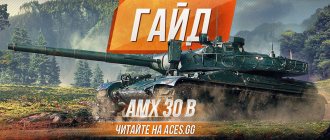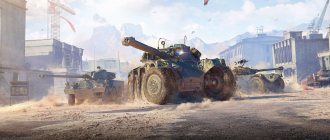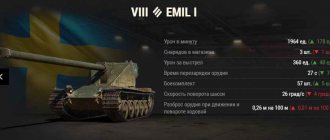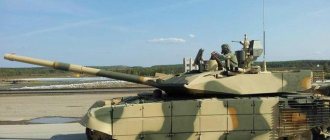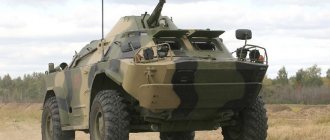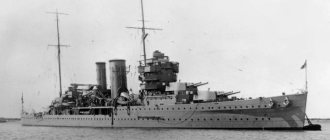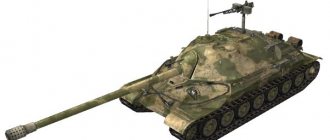KV-13 is a collectible medium tank of the 7th lvl of the Soviet branch. Before patch 5.5, he was a pumpable tank and a frequent guest of random. After update 5.5, it was removed from the game; it was left for players who upgraded the car, giving it collectible status. At the moment (patch 5.6) it is impossible to obtain. What kind of animal is this, how much does it farm, how does it feel in random?
General information about the KV-13.
The KV-13 World of Tanks is quite well armored and has excellent dynamics, but the power of this tank is quite weak compared to similar models. This combat unit has a fairly powerful 122 mm gun, which shows itself rather poorly in battles; it is recommended to use an 85 mm gun (D-5T-85BM), which has 144 mm penetration with 180 HP damage. Considering the rate of fire is up to 10 rounds per minute, the result is quite good efficiency.
The speed reaches 50 mph, which allows this model to provide good support all over the map, actively moving from position to position. The reverse reserve is 20 km/h. Engine with a power of 500 hp. copes well with the weight of the tank, which reaches 33 tons. The visibility is 340 meters, quite acceptable visibility for the middle class.
The armor of the KV-13 tank is:
- Hull: forehead - 120 mm, sides - 85 mm, stern - 85 mm.
- Tower: front - 85 mm, side projection - 85 mm, rear - 85 mm.
Excellent turret armor for this level allows it to perform well in battle if there are shelters nearby that can hide the hull from enemy fire.
Review of KV-1S
KV-1S heavy tank tier 6. I got two guns to choose from: a 122 mm howitzer and an 85 mm more stable gun with a high DPM of 1920 units. Fast reloading allows you to fire 12 shots in a minute. The low armor penetration of the basic 119 mm projectile makes it difficult to realize damage. The aiming time is acceptable 2.5 seconds, but the accuracy leaves much to be desired at 0.46. The vertical guidance angles are awkward -4…+15°.
Durability 640 units. At the top of the list, he can “butt” with enemy heavies, pushing the direction or defending. It has good all-round hull armor with rational armor angles. But the turret is not armored, so you shouldn’t expose the enemy to anything other than the gun mantlet.
The high fire hazard due to vulnerable tanks must be taken into account.
Excellent speed of 43 km/h allows you to enter the enemy’s flank or return to defend the base. At the bottom of the list, armor will not help, so it is better to support medium tanks or cover heavy tanks at medium distance. The KV-1S is more of a hybrid of a medium and heavy tank, so it requires careful play; you cannot mindlessly rush into enemy positions with it. Another drawback is the small visibility of 340 meters.
TTX
Recommended modules for the KV-13 tank.
Being a representative of Soviet tank building, the KV-13 simply needs additional modules, since all Soviet combat units have some disadvantages:
- Rammer – this module can be installed on any type of equipment;
- Improved ventilation – quite significantly improves the crew’s skills, which is noticeable during hot battles;
- Reinforced aiming drives will significantly increase the accuracy of the gun when moving.
Click and read: Stridsvagn Tank 74 guide World of Tanks
For the KV-13 it is also recommended to use a standard set of equipment:
- First aid kit;
- Repair kit;
- Twisted speed controller.
Equipment
Because Our magnificent weapon has a low reload speed, so first of all, install the Rammer in order to somehow speed up the reload. The second number should be Reinforced aiming drives, for quick aiming of the gun. And the third point: Improved ventilation is a simple and universal module that will happily improve all the performance of your tank! It can also be replaced with tanks containing carbon dioxide. On my own behalf, I would like to add that I used to ride without knowing what a Fire Extinguisher, Repair Kit and First Aid Kit are. But starting with the KV-1, we are faced with 2 of the most important problems - a fire in the engine and a downed hull. Believe me, these problems will remain on the KV-1S. Also, very often on the KV-1S, I personally have the driver mechanic disabled, as a result of which the turning speed of the turret and the tank itself slows down, so we bought a First Aid Kit, a Repair Kit and a Fire Extinguisher and let’s go get medals!
PS
When you get off the KV-1 and sit on a stock KV-1S, don’t cry! Yes, while Kvass is stock, it is almost worse than the KV-1, but be patient! Under no circumstances should you sell a high explosive with a KV-1; you can ride with it on a Kvass for some time. And remember! If on the KV-1, being at the top, we were like a wall that was unbreakable for almost everyone, then Kvass is a little weaker in this regard. When playing this tank, you have to think and be cunning, have some kind of tactics. don’t forget to hide behind the houses and corpses of noobs who decided to go rush!
I hope you enjoy the guide) All good luck)
Useful Soviet TT
Weaknesses of the KV-13.
The KV-13 tank, like all representatives of World of Tanks, has its weaknesses. When meeting head-on on the battlefields, it is recommended to try to fire shots at the driver’s window, which is located under the turret, so you can cause critical damage to the crew and damage the combat vehicle itself. It is also worth considering the commander's cupola on the tower; it almost always breaks through. You can also attack the seam connecting the upper armor plate to the lower armor plate. This area is also easy to penetrate, but you should not try to attack it if the tank is at an angle towards you.
https://youtube.com/watch?v=ZH8RFe5LLo0
Photo KV 13
As for the side of the tank, first of all you should try to fire at the rear part, this is where the gas tanks and the tank engine are located. It is worth trying to break through the side of the tower; it is recommended to attack the area to the right of the star; in this situation, you can blow up the ammunition storage. Don't forget about the front roller of the tank, which not only penetrates well, but also makes the tank stop.
If you manage to get into the stern of the enemy, then the only area of attack is the entire stern part; it penetrates well to any point. You can try to break through the machine gun mantlet on the turret; after successful penetration, the ammunition rack may explode
The first HF with an unlucky number
Cases where vehicles that never made it to mass production became epoch-making are not uncommon in the history of tank building. The Soviet tank KV-13 is one of them. This vehicle is often called a “heavily armored medium tank,” which is fundamentally incorrect. From the very beginning, the KV-13 was designed precisely as a heavy tank. The revolutionary machine fully met the new requirements of the Soviet military. It became the first maneuverable heavy tank, which combined solid armor for that time with a relatively low weight, and most importantly
–
with high mobility.
The KV-13 appeared at a very difficult time, partly for this reason it never went into production. However, the further development of Soviet tank building took place under the influence of the latest development of the talented designer Nikolai Valentinovich Tseits.
Fallback option
The exact date of the start of work on a combat vehicle that is fundamentally new for the team of the Chelyabinsk Kirov Plant is shrouded in darkness. There is an opinion that work on the KV-13 began back in 1941, but this is not true. This version was put forward on the basis that the KV-13 was allegedly mentioned in the list of ongoing experimental work for 1942, aimed at the approval of Zh.Ya. Kotin December 22, 1941. In fact, on this list is not the KV-13, but the KV-3, work on which at that time no one had removed from ChKZ.
Moreover, in December 1941, problems with overloading the KV-1 chassis had not yet fully manifested themselves. At that time, the heavy tank, on the contrary, was further strengthened both in terms of armor and armament. If problems with the transmission and reduced mobility had not become constant companions of the heavy tank, then by the spring-summer of 1942 the Red Army could have received its own Tiger. At least from the point of view of armament, power plant power and level of protection, these would be very similar tanks.
Further developments showed that the Soviet “Tiger” was not destined to appear. To begin with, the 85-mm U-12 gun “died” without being born. Further, at the end of January 1942, Stalin raised the issue of the insufficient mobility of the KV-1. There is nothing surprising in this, since by that time the combat weight of the tank had reached 50 tons. Two ways to solve this problem were chosen - increasing engine power to 650–700 horsepower and simultaneously reducing weight.
Draft design of the KV-13 heavy tank, May 1942
Work to increase the power of the V-2K began in February 1942. It quickly became clear that such a measure was clearly not enough, since the cooling system of a tank with such an engine quickly overheated. The cooling system also needed to be redesigned. On February 23, 1942, GKO decree No. 1331 was issued, which provided for a reduction in the mass of the HF by 1.3 tons. By that time, a much more serious problem had come to the fore. Gearboxes on overloaded tanks began to fail frequently. It became clear that the KV-1 required a serious design redesign.
In March 1942, gearbox failures became a real disaster. It was at this moment that SKB-2 ChKZ began to work on a deep modernization of the KV-1. It involved some lightening of the design of the vehicle and alteration of a number of units, but the general concept of the tank remained the same. Work on this topic formed the basis for the KV-1s heavy tank.
In parallel with this, work began on a completely new tank. N.V. Tseits was appointed senior engineer of the machine, which received the designation KV-13. Nikolai Valentinovich belonged to the representatives of the first generation of Soviet tank engineers. He stood at the origins of Soviet tank building, taking part in the development of the famous MS-1. On October 2, 1930, he was arrested on charges of counter-revolutionary activities. So he ended up in the design bureau of the technical department of the Economic Directorate of the United State Political Directorate (EKU OGPU), where, together with N.A. Astrov worked on the PT-1 and PT-1A amphibious tanks. He continued to work there after his early release on April 22, 1932.
In 1934, Zeitz moved from Moscow to Leningrad, where he took one of the key positions at the Experimental Plant No. 185 named after. Kirov, at that time the leading developer of tanks and self-propelled guns in the USSR. In a new place, Nikolai Valentinovich continued the work begun at the EKU OGPU on the topic of a medium wheeled-tracked tank, better known as the T-29.
The unfortunate fate of the T-29 directly affected the fate of Zeitz himself: first he was removed from work on the SMK-1 tank, and then arrested. The designer could well have shared the fate of Firsov, Shukalov, Ivanov, Syachintov and others who fell into the millstones of repression, but he was lucky. It is not known who put in a good word for Zeitz, but already in the winter of 1941 he returned to work as a design engineer.
Yuri Pasholok
/
Tank building on the verge of common sense
Unusual projects of Soviet heavy tanks KV-4 and KV-5
- WWII
- tanks
- USSR
His new place of work was SKB-2 of the Kirov plant, where Zeitz was designing his own version of the KV-4 heavy tank. His 90-ton preliminary design, distinguished by its original execution, was awarded a prize of 2,000 rubles. In many ways, this project became the basis for another heavy tank, the KV-5.
Nikolai Valentinovich also worked on the topic of the KV-1 tank. In particular, in July 1941, he proposed an original method for cooling the engine. In the fall of 1941, Tseits and other employees of the Kirov plant were evacuated to Chelyabinsk. According to the memoirs of N.F. Shashmurin, Zeitz was sent to the Northern Urals, where he dealt with gold mining issues. He was brought back into tank building by the People's Commissar of the Tank Industry V. A. Malyshev at the instigation of the Deputy Head of the Technical Department of the NKTP S. A. Ginzburg, with whom Tseitz worked together at Plant No. 185.
Longitudinal section of KV-13. The drawing stamp shows that the vehicle is called KV-13. The senior engineer of the machine is N.V. Zeitz
In Zeitz, the design group received a boss who was capable of working on complex problems. And the team was given an extremely non-trivial task. The first year of the Great Patriotic War clearly showed that the heavy tank in the form in which the Soviet military saw it before the war was no longer suitable for them. A heavy tank now required not only high security, but also tactical mobility. The KV-1 ceased to suit them in this regard, and this is even without taking into account all the reliability problems that have piled up. The standard tank was recognized as the medium T-34, which was more than 1.5 times lighter than the KV-1. In a word, the military wanted to get a tank with the mobility of the T-34 and in approximately the same weight category, but with armor protection at the level of the KV-1.
Requirements of GABTU KA for the manufacture of heavy tanks of the 30-ton class. These vehicles were to be the KV-13 and a medium tank, which was called the T-44
Some sources (for example, Shashmurin) call the KV-13 an attempt to create a competitor for the T-34, while “demonizing” the image of Kotin. In fact, the initiator of the appearance of the “heavily armored medium tank,” as the KV-13 is often called, was the leadership of the Main Armored Directorate of the Red Army (GABTU KA). The task to develop a heavy tank with a medium weight was issued not only to Chelyabinsk, but also to Nizhny Tagil. On June 1, 1942, the GABTU KA prepared a document that provided for the production at plant No. 183 of a prototype T-44 tank with a combat weight of about 30 tons. Whether this was the same T-44 (A-44) that was designed at plant No. 183 in 1941, or whether we are talking about a new vehicle is unknown. In parallel with this, the task was given to manufacture a 30-ton heavy tank by ChKZ. Here we were talking about the KV-13.
Thus, calling this tank a medium tank, much less classifying it as a direct competitor to the T-34, is at least not entirely correct.
Stamp of the drawing of the IS-1 heavy tank, SKB plant No. 100, May 1942
The designation of a promising heavy tank, which was carried out by Zeitz’s group, deserves a separate discussion. Nikolai Valentinovich was a pious and superstitious man. He was not at all happy with the fact that his topic was assigned a “damn dozen.” Zeitz tried by hook or by crook to get rid of this index, and he partially succeeded. In March 1942, a pilot plant No. 100 was organized at ChKZ, and N.N. became its director. Voroshilov. N.M. was appointed chief engineer of the plant. Sinev, and chief designer A.S. Ermolaeva. Work on the KV-13 was partially transferred to plant No. 100; this machine became one of the first works of the pilot plant. It was at this moment that the car began to pass under two designations. Since the correspondence was mainly carried out through ChKZ, in the documents it was listed as KV-13. But in the design documentation of SKB plant No. 100, a completely different name was used - IS-1.
It is also worth noting that the often used designation “Object 233” has nothing to do with this tank. Like other vehicles of the Kirov plant, the KV-13/IS-1 received a drawing code - 233. This was the next number after the KV-12 (232). And the word “Object” began to be used in relation to the vehicles being developed at ChKZ and plant No. 100 only in the summer of 1943, when the KV-13 topic had already been closed for six months. In a word, the designation “Object 233” in relation to the original KV-13 is the creation of not entirely conscientious researchers.
Text of the draft resolution of the State Defense Committee on the release of prototypes of the KV-13. As you can see, by July 1 the tower was supposed to be made three-seater
The general appearance of the KV-13 was formed in May 1942. Specific requirements for the vehicle led to the fact that the heavy tank had the dimensions and combat weight of a medium tank. During development, the creators of the KV-13 looked back at the T-34. Separate elements of the chassis were taken from the medium tank, in particular the track tracks and a slightly modified drive wheel. In addition, the turret was also clearly designed with the T-34 in mind. At first it was designed as a two-seat turret, but by the beginning of the summer of 1942 it was decided to convert the turret into a three-seat one. At the same time, it was planned to install a commander's cupola and install a rear machine gun. Although the three-person tower remained a project, this work was not in vain. In a slightly modified form, this design became the KV-1s turret.
Project KV-13 with a three-man turret
Despite the fact that the KV-13 index included the designation “KV,” this vehicle had little in common with the KV-1. The engine, torsion shafts and a number of other elements were taken from the founder of the KV family for the new tank. However, it is also not worth saying that the KV-13 was a machine entirely built using new technical solutions. Engineers from ChKZ and plant No. 100 used existing experience in design. The hull with the driver's seat located in the center of the control compartment was already designed for the T-50 light tank designed by the Kirov plant. From there, the design of the installation of the course machine gun was partially borrowed, as well as the cooling system with the characteristic arrangement of radiators. For the sake of such an installation, it was necessary to make a clearly visible “hump” on the roof of the engine compartment. The air intakes on the roof of the engine compartment were very similar to those used on several KV-4 projects.
But there were also plenty of new solutions. For example, it was supposed to use a 9-speed gearbox with a triple range, developed by engineer F.A. Marishkin. It is also worth noting the large percentage of cast parts used in the construction of the hull and turret. This made it possible to simplify the production technology and at the same time reduce the reserved volume. The released mass made it possible to significantly strengthen the reservation. According to the first version, the maximum thickness of the hull and turret armor was 90 mm, by the beginning of July 1942 it increased to 100 mm, and in the final version the hull armor was strengthened to 120 mm. At the same time, the design weight of the empty hull was 13,250 kg, and the empty turret was 4,150 kg.
Between T-34 and KV-1s
On June 5, 1942, a meeting was held in which Stalin and V.A., who held the position of People's Commissar of the Tank Industry, took part. Malyshev. During the meeting, the start of work on the KV-1s heavy tank was finally approved. Also shown here were models of promising heavy tanks from factory No. 183 and ChKZ. Malyshev mentions this in his memoirs:
“We showed Comrade Stalin models of two new tanks, which completely meet those wishes... but Comrade Stalin replied: “We will not make new tanks for now. Let's not distract designers from the task of improving and modernizing the tanks being produced. Of course, designers want to make new cars, every designer seeks fame. But we have to wait. We’ll return to the new vehicles in about a month and a half or two, when the designers finish work on improving the existing tanks.”
Prototype KV-13, end of September 1942
Stalin's decision was fully reflected in GKO Decree No. 1878 “On the improvement of KV tanks,” signed on June 5, 1942. The 9th and 10th points of this document concerned specifically the KV-13. According to them, by August 10, 1942, it was planned to produce two prototypes of the machine. Stalin himself deleted both points from the text of the resolution.
He's in front. The tracks taken unchanged from the T-34 are clearly visible
Despite this decision, work on the KV-13 still continued, but to a much smaller extent. Basically, they were working on it at that moment at plant No. 100, and the employees of SKB-2 ChKZ were developing the KV-1s at an accelerated pace. The experience of designing the KV-13 was very useful when creating a modernized heavy tank. On the other hand, some solutions that were worked out for the KV-1s were also transferred to the promising tank.
The decision to freeze the KV-13 program did not prevent work on individual elements of the tank. For this purpose, a KV-1 with serial number 25810 was taken. From July 1942, they began to work on the elements of the KV-13 chassis, in particular the support and support rollers.
KV-13 from behind. The design with two transmission access hatches in the upper rear plate would later become the hallmark of the IS series tanks
The next attack on the KV-13 took place on July 3, 1942. At this time, GKO decree No. 1958 “On T-34 and T-70 tanks” was issued, according to which the production of T-34 was organized at ChKZ. All the forces of the enterprise were thrown into a new task, for the sake of which it was necessary to reduce the production of the KV-1. The organization of production of the T-34 greatly influenced the work on the KV-1s; as for the KV-13, activity on it completely died down for a while. Moreover, there was a threat of final closure of the program.
It is likely that Zeitz's death from a heart attack on July 19, 1942 was partly related to this situation. Versions about what exactly caused the designer’s death vary. For example, Shashmurin in his memoirs blamed Kotin for what happened. But most likely the cause of the heart attack was Zeitz’s worry about the fate of the next tank, the development of which he headed and which again could be out of work.
In profile, the KV-13 closely resembled the T-34. However, it was the heavy tank that was designed in Chelyabinsk
N.F. was appointed to the position of senior engineer of the orphaned machine. Shashmurin. Judging by Nikolai Fedorovich’s memoirs, he frankly did not like this car. Nevertheless, it was Shashmurin who was to bring Zeitz's work to completion. Due to the workload on the KV-1s and T-34, development of the KV-13 resumed only in September 1942. The design and assembly of the tank was carried out by pilot plant No. 100.
The characteristic design of the radiators, also migrated from the T-50, is clearly visible
On September 14, a telephone message from I.M. arrived at the plant. Zaltsman, who demanded that all experimental work at the plant be stopped. Plant No. 100 was supposed to ensure the deployment of T-34 production at ChKZ. However, work on the KV-13 never stopped. By September 13, its hull and turret were ready, and on the same day the plant made markings for the installation of components and assemblies. When weighed, it turned out that the mass of the hull and turret was less than calculated - 12,900 and 3,600 kilograms, respectively.
The design of the drive wheels was very similar to those installed on the T-34. However, their configuration was slightly different
Assembly began on September 13th. As is often the case with experimental products, in some cases inconsistencies occurred. The control lever brackets had to be welded onto the evacuation hatch, and there was no room for the main clutch rod bracket on the bottom of the hull. The final drives did not fit into the mounting holes of the hull, and in addition, problems arose with the installation of fuel tanks. Similar problems plagued the factory workers almost throughout the entire assembly process. In total, it took a little less than two weeks to receive the remaining units and complete the assembly of the machine.
KV-13 support roller close-up
In general, the KV-13 prototype corresponded to the tank design created under the leadership of Zeitz. Of course, there were certain changes, including in the chassis. Instead of track rollers with internal shock absorption, which in their design resembled the T-50 LKZ rollers, all-metal rollers were developed for the KV-13. They turned out to be simpler and lighter. Sloths were redesigned in a similar way. Although the overall configuration of the tower remained unchanged, some improvements were made to its design. Some of them migrated from the KV-1s, especially the handrails.
Not a day without troubles
The KV-13 went on its first test run on September 26, 1942. During its course, all the transmission and chassis mechanisms worked normally, but even then the first breakdowns occurred. At increased engine speeds, the oil pressure dropped to two atmospheres. The cause was quickly identified - a malfunction of the engine oil gearbox. The next day brought much more problems, when the maximum speed of the tank was determined to be 55 km/h. It was possible to measure it based on the readings of the GAZ M1 car coming behind. The results were quite satisfactory, but the tests ended with a whole bunch of malfunctions. At the 30th kilometer, the performance of the gearbox drive deteriorated, the engine began to overheat, and weak traction was observed in 9th gear. Finally, the covers on three road wheels came off and were lost. It was also noted that the car was very difficult to control.
KV-13 during testing, October 1942
The run on September 26–27 is mentioned in Shashmurin’s book “50 Years of Confrontation.” In these memoirs, the talented designer fully expressed his attitude towards the idea of making a heavy tank with the mass and dimensions of a medium one. Partly, it was his behavior during the tests that led to the breakdowns, which Nikolai Fedorovich wrote about, not without pleasure (although in his memoirs the first and second samples of the KV-13 were mixed):
“It should be borne in mind that in factory conditions, during acceptance tests, drivers have become adept at avoiding dangerous loads, the nature of the test routes is known and mastered, and the scope of testing is extremely limited. There are cases of uncontrolled replacement of defective parts, etc.
Having drawn up a special task for running only 50 kilometers, I carried it out in a special mode. Route: Chelyabinsk-Kopeisk-back. The route is an unpaved cobblestone road. Crew: Shashmurin – deputy. G. designer, Kovsh - master of driving, Rozov - military representative.
Kovsh was driving the car in one direction. Everything went well, only small cracks were found on a couple of road wheels. I drove the car back myself, at extremely high speeds. I arrived at the plant with broken rollers. A scandal was created, and later he got into big trouble for this “amateur activity.” But the fate of the KV-13 tank was sealed, this phenomenon died.”
Shashmurin took a great risk, since he could be accused of sabotage. In general, Nikolai Fedorovich was right - the tank turned out to be very crude and extremely doubtful from the point of view of a possible launch into series. The skating rink episode was just one of a long list of problems. For example, the wording “heavy control” hid the fact that the force on the levers was up to 60 kilograms, and on the main clutch pedal – 90 kilograms. There were a lot of other problems related to the convenience of the driver. There were also problems with servicing the car, for example, it turned out to be impossible to remove the air filter without dismantling the oil radiators. Troubles were discovered with the track tensioning mechanism, which could not be attributed to the consequences of reckless driving. Finally, design flaws with the turret appeared: during movement, the turret stop spontaneously turned away, and the locks of the pistol ports were declared unsuitable for use.
Overcoming the climb. The tank engine overheated at high speeds
The extent to which the problems were identified during the first run of the KV-13 is evidenced by the fact that it took more than a week to fix the defects. After altering the mechanisms for attaching the levers, the force on them was reduced to 24 kilograms. Much more interesting is that the idea of a chassis using elements of the T-34 was considered unsuccessful. After eliminating the shortcomings, testing continued. And at plant No. 100 they began to work on the production of a second set of transmission mechanisms and chassis. It was decided to replace the tracks with KV ones, and the drive wheels were made in the same way as the KV ones.
KV-13 in the forest
On October 5, the converted KV-13 entered its third run, covering a distance of 35 kilometers. It turned out that the tensioning mechanism screw came loose while driving, as a result of which the caterpillar often weakened and tore the wings. The right wing was completely torn, the mounting bolts were torn off from the left. The loss of the wings affected engine performance as flying dirt clogged the air intakes. The transmission worked reliably, but the engine tended to overheat at high speeds. Upon returning to the plant, the KV-13 underwent repairs, which lasted a week. The next time the tank set off on October 13, covering 85 kilometers. The air intakes continued to be pelted with earth, as did the engine overheating. Problems with the track tension mechanism have not gone away either. Problems with the gearbox were added to the old problems. Troubles with the checkpoint continued in the next two races, which took place on October 16 and 19.
Almost every trip of the tank was accompanied by various breakdowns
In total, in September-November 1942, the KV-13 covered 715 kilometers, during which about 50 different defects were discovered. After traveling 565 kilometers, the tank's tracks from the T-34 were replaced with tracks from the KV-1s, and the drive wheels were also changed at the same time. This cannot be said to have greatly improved the situation. During the run on November 3, three cases of the track coming out of engagement with the drive wheel sprocket were recorded. Other shortcomings were also revealed, for example, a large number of cracks in the bottom through which water entered the tank.
KV-13 in final configuration, summer 1943. By that time it had become a museum exhibit. In the background you can see the second version of the KV-13, which shared the fate of its predecessor.
Despite the fact that until the end of 1942 the vehicle participated in various tests, it became clear that it was clearly a failure. They also understood this at ChKZ. It is not surprising that work began in November on the development of an improved KV-13. This tank was noticeably different from its predecessor. As for the first KV-13, it turned out to be at the same time the first step towards the IS-2, the best Soviet heavy tank of the war period and, perhaps, the best heavy tank of the entire Second World War.
The author thanks Igor Zheltov (Moscow) for his assistance in preparing this material.
Sources:
- RGAE materials
- Materials from TsAMO RF
- RGASPI materials
- Materials from the archive of Gennady Malyshev
How to play
With the more accurate ZiS-6 107 mm gun, the tank feels more confident at medium and long distances.
With the M-10 152 mm gun, try to target the vulnerable spots of tanks (kamluks, roofs, machine guns, slots in mechanical drives, etc.) and shoot at the armor without tilting. If you shoot at weak armor, but at large angles, then most likely the high-explosive projectile will not penetrate and will do half, or even less than half, damage. Also, do not shoot at the caterpillar, as it eats up the damage dealt very much.
In battle, when you are at the bottom of the list, try not to attack high-level opponents. Your task in such a battle is to support allied equipment. Cover yourself with allied heavy tanks and carefully deal damage to enemies
The KV-2 has pretty good armor, but it’s still not worth breaking through the defenses alone. The KV-2 is a very large tank and is not difficult to hit. A couple of juicy splashes and you will be sent to the hangar.

